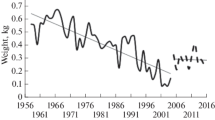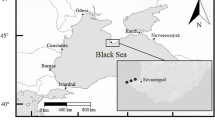Abstract
With the decline in the most fisheries resources in the Yellow Sea, the yellow goosefish Lophius litulon has increased in commercial and ecological importance in recent years. We studied the length distribution, length-weight relationship, age composition, growth pattern, mortality, and exploitation rates of the yellow goosefish in the Yellow Sea. Total length (TL) of females and males ranged from 173 to 582 mm and 178 to 500 mm, respectively. The length-weight relationships were also estimated for females and males. Age classes from 2 to 4 years predominated in the samples. The von Bertalanffy growth function (VBGF), estimated based on non-linear least-squares methodology, showed significant differences between sexes. Females attained a greater estimated asymptotic total length (765 mm TL) compared to males (579 mm TL). The VBGF did not differ significantly between stocks of the northern Yellow Sea and the southern Yellow Sea. Estimated natural instantaneous mortality rate (M) ranged from 0.25/a to 0.33/a based on four age- and length-based methods. Total instantaneous mortality rate (Z) of total samples calculated by the age-based catch curve method was 0.591/a and the average fishing mortality (F) was 0.30/a. Estimated exploitation rate (E) was approximately 0.5, indicating that the population of L. litulon in the Yellow Sea may be sustainable. These results provide a reference for the present status of L. litulon and information for the management.
Similar content being viewed by others
Data Availability Statement
The data generated or analyzed during the current study are available from the corresponding author on reasonable request.
References
Begg G A, Hare J A, Sheehan D D. 1999. The role of life history parameters as indicators of stock structure. Fisheries Research, 43(1–3): 141–163, https://doi.org/10.1016/s0165-7836(99)00071-5.
Beverton R J H, Holt S J. 1957. On the Dynamics of Exploited Fish Populations. Her Majestys Stationery Office, London. p. 1–533.
Campana S E. 2001. Accuracy, precision and quality control in age determination, including a review of the use and abuse of age validation methods. Journal of Fish Biology, 59(2): 197–242, https://doi.org/10.1111/j.1095-8649.2001.tb00127.x.
Chen G B, Li Y Z, Chen P M, Shu L M. 2008. Optimum interval class size of length-frequency analysis of fish. Journal of Fishery Sciences of China, 15(4): 659–666. (in Chinese with English abstract)
Chen Y, Jackson D A, Harvey H H. 1992. A comparison of von Bertalanffy and polynomial functions in modelling fish growth data. Canadian Journal of Fisheries and Aquatic Sciences, 49(6): 1 228–1 235, https://doi.org/10.1139/f92-138.
Fariña A C, Azevedo M, Landa J, Duarte R, Sampedro P, Costas G, Torres M A, Cañás L. 2008. Lophius in the world: a synthesis on the common features and life strategies. ICES Journal of Marine Science, 65(7): 1 272–1 280, https://doi.org/10.1093/icesjms/fsn140.
Froese R, Thorson J T, Reyes Jr R B. 2014. A Bayesian approach for estimating length-weight relationships in fishes. Journal of Applied Ichthyology, 30(1): 78–85, https://doi.org/10.1111/jai.12299.
Froese R, Tsikliras A C, Stergiou K I. 2011. Editorial note on weight-length relations of fishes. Acta Ichthyologica et Piscatoria, 41(4): 261–263, https://doi.org/10.3750/aip2011.41.4.01.
Froese R. 2006. Cube law, condition factor and weight-length relationships: history, meta-analysis and recommendations. Journal of Applied Ichthyology, 22(4): 241–253, https://doi.org/10.1111/j.1439-0426.2006.00805.x.
Gray C A, Barnes L M, Robbins W D, Van Der Meulen D E, Ochwada-Doyle F A, Kendall B W. 2017. Length- and age-based demographics of exploited populations of stout whiting, Sillago robusta Stead, 1908. Journal of Applied Ichthyology, 33(6): 1 073–1 082, https://doi.org/10.1111/jai.13464.
Haddon M. 2015. Modelling and Quantitative Methods in Fisheries. Chen P M, Qin C X, Yuan H R, Jia X Y, Zhou W L, trans. 2nd edn. Ocean Press, Beijing, China. 367p. (in Chinese)
Hewitt D A, Hoenig J M. 2005. Comparison of two approaches for estimating natural mortality based on longevity. Fishery Bulletin, 103(2): 433–437.
Hilborn R, Walters C J. 1992. Quantitative Fisheries Stock Assessment: Choice, Dynamics & Uncertainty. Springer, Boston, MA. 570p.
Hoenig J M. 1983. Empirical use of longevity data to estimate mortality rates. Fishery Bulletin, 82(1): 898–903.
Jin X S, Tang Q S. 1996. Changes in fish species diversity and dominant species composition in the Yellow Sea. Fisheries Research, 26(3–4): 337–352, https://doi.org/10.1016/0165-7836(95)00422-X.
Jin X S, Zhang B, Xue Y. 2010. The response of the diets of four carnivorous fishes to variations in the Yellow Sea ecosystem. Deep Sea Research Part II: Topical Studies in Oceanography, 57(11–12): 996–1 000, https://doi.org/10.1016/j.dsr2.2010.02.001.
Le Cren E D. 1951. The length-weight relationship and seasonal cycle in gonad weight and condition in the perch (Perca fluviatilis). Journal of Animal Ecology, 20(2): 201–219.
Li Z L, Jin X S, Shan X J, Dai F Q. 2011. Inter-annual changes on body weight-length relationship and relative fatness of small yellow croaker (Larimichthys polyactis). Journal of Fishery Sciences of China, 18(3): 602–610, https://doi.org/10.3724/SP.J.1118.2011.00602. (in Chinese with English abstract)
Li Z L, Shan X J, Jin X S, Dai F Q, Lu H S. 2015. Interannual variations in the biological characteristics, distribution and stock density of anglerfish Lophius litulon in the central and southern Yellow Sea. Acta Ecologica Sinica, 35(12): 4 007–4 015, https://doi.org/10.5846/stxb201310262585. (in Chinese with English abstract)
Li Z L. 2011. Interannual Changes in Biological Characteristics of Small Yellow Croaker Larimichthys polyactis, Pacific Cod Gadus macrocephalus and Anglerfish Lophius litulon in the Bohai Sea and Yellow Sea. The Institute of Oceanology, Chinese Academy of Sciences, Qingdao, China. p. 1–117. (in Chinese with English abstract)
Link J S, Nye J A, Hare J A. 2011. Guidelines for incorporating fish distribution shifts into a fisheries management context. Fish and Fisheries, 12(4): 461–469, https://doi.org/10.1111/j.1467-2979.2010.00398.x.
Lloret J, De Sola L G, Souplet A, Galzin R. 2002. Effects of large-scale habitat variability on condition of demersal exploited fish in the North-western Mediterranean. ICES Journal of Marine Science, 59(6): 1 215–1 227, https://doi.org/10.1006/jmsc.2002.1294.
Ma S Y, Liu Y, Li J C, Fu C H, Ye Z J, Sun P, Yu H Q, Cheng J H, Tian Y J. 2019. Climate-induced long-term variations in ecosystem structure and atmosphere-ocean-ecosystem processes in the Yellow Sea and East China Sea. Progress in Oceanography, 175: 183–197, https://doi.org/10.1016/j.pocean.2019.04.008.
Pang Y M, Tian Y J, Fu C H, Wang B, Li J C, Ren Y P, Wan R. 2018. Variability of coastal cephalopods in overexploited China Seas under climate change with implications on fisheries management. Fisheries Research, 208: 22–33, https://doi.org/10.1016/j.fishres.2018.07.004.
Park K A, Lee E Y, Chang E, Hong S. 2015. Spatial and temporal variability of sea surface temperature and warming trends in the Yellow Sea. Journal of Marine Systems, 143: 24–38, https://doi.org/10.1016/j.jmarsys.2014.10.013.
Park S, Chu P C, Lee J H. 2011. Interannual-to-interdecadal variability of the Yellow Sea Cold Water Mass in 1967–2008: characteristics and seasonal forcings. Journal of Marine Systems, 87(3–4): 177–193, https://doi.org/10.1016/j.jmarsys.2011.03.012.
Patterson K. 1992. Fisheries for small pelagic species: an empirical approach to management targets. Reviews in Fish Biology and Fisheries, 2(4): 321–338, https://doi.org/10.1007/BF00043521.
Pauly D. 1980. On the interrelationships between natural mortality, growth parameters, and mean environmental temperature in 175 fish stocks. ICES Journal of Marine Science, 39(2): 175–192, https://doi.org/10.1093/icesjms/39.2.175.
Quinn II T J, Deriso R B. 1999. Quantitative Fish Dynamics. Oxford University Press, Oxford. 542p.
Rätz H J, Lloret J. 2003. Variation in fish condition between Atlantic cod (Gadus morhua) stocks, the effect on their productivity and management implications. Fisheries Research, 60(2–3): 369–380, https://doi.org/10.1016/S0165-7836(02)00132-7.
Ricker W E. 1975. Computation and interpretation ofbiological statistics of fish populations. Bulletin of the Fisheries Research Board of Canada, 191: 1–382.
Romo-Curiel A E, Herzka S Z, Sosa-Nishizaki O, Sepulveda C A, Aalbers S A. 2015. Otolith-based growth estimates and insights into population structure of White Seabass, Atractoscion nobilis, off the Pacific coast of North America. Fisheries Research, 161: 374–383, https://doi.org/10.1016/j.fishres.2014.09.004.
Russell E S. 1942. The Overfishing Problem. Cambridge University Press, Cambridge. 130p.
Stevenson R D, Woods Jr W A. 2006. Condition indices for conservation: new uses for evolving tools. Integrative and Comparative Biology, 46(6): 1 169–1 190.
Sun G W, Shen J Z, Hu S D, Gong C, Wang H S, Huang D. 2013. Age, growth and mortality of Pseudobrama simoni (Bleeker) in Tian-e-zhou Oxbow of the Yangtze River. Freshwater Fisheries, 43(4): 29–34, https://doi.org/10.3969/j.issn.1000-6907.2013.04.006. (in Chinese with English abstract)
Takeya Y, Takatsu T, Yamanaka T, Shibata Y, Nakaya M. 2017. Use of the illicium for age determination and verification of yellow goosefish Lophius litulon off Aomori Prefecture, northern Japan. Nippon Suisan Gakkaishi, 83(1): 9–17, https://doi.org/10.2331/suisan.16-00041. (in Japanese with English abstract)
Vila-Gispert A, Moreno-Amich R. 2001. Fish condition analysis by a weighted least squares procedure: testing geographical differences of an endangered Iberian cyprinodontid. Journal of Fish Biology, 58(6): 1 658–1 666, https://doi.org/10.1111/j.1095-8649.2001.tb02320.x.
Von Bertalanffy L. 1938. A quantitative theory of organic growth (inquiries on growth laws. II). Human Biology, 10(2): 181–213.
Wei Q S, Li X S, Wang B D, Fu M Z, Ge R F, Yu Z G. 2016. Seasonally chemical hydrology and ecological responses in frontal zone of the central southern Yellow Sea. Journal of Sea Research, 112: 1–12, https://doi.org/10.1016/j.seares.2016.02.004.
Xu B D, Jin X S. 2005. Variations in fish community structure during winter in the southern Yellow Sea over the period 1985–2002. Fisheries Research, 71(1): 79–91, https://doi.org/10.1016/j.fishres.2004.07.011.
Xu K D, He Z T, Li P F, Xue L J, Zhu W B. 2010. Age and growth of Lophius litulon in North of the East China Sea and south of the Yellow Sea. Progress in Fishery Sciences, 31(6): 9–14, https://doi.org/10.3969/jissn.1000-7075.2010.06.002. (in Chinese with English abstract)
Yamada U, Tokimura M, Horikawa H, Nakabo T. 2007. Fishes and fisheries of the East China and Yellow Seas. Tokai University Press, Kanagawa, Japan. (in Japanese)
Yamada U. 1986. Lophiomus setigerus and Lophius litulon. In: Yamada U, Tagawa M, Kishida S, Honjo K eds. Fishes of the East China Sea and the Yellow Sea. Seikai Regional Fisheries Research Laboratory, Nagasaki, p.106–109. (in Japanese)
Yoneda M, Tokimura M, Fujita H, Takeshita N, Takeshita K, Matsuyama M, Matsuura S. 2001. Reproductive cycle, fecundity, and seasonal distribution of the anglerfish Lophius litulon in the East China and Yellow seas. Fishery Bulletin, 99(2): 356–370.
Yoneda M, Tokimura M, Fujita H, Takeshita N, Takeshita K, Matsuyama M, Matsuura S. 1997. Age and Growth of anglerfish Lophius litulon in the East China Sea and the Yellow Sea. Fisheries Science, 63(6): 887–892.
Acknowledgment
We thank the investigators who participated in the seasonal bottom trawl survey.
Author information
Authors and Affiliations
Corresponding author
Additional information
Supported by the National Key R&D Program of China (No. 2018YFD0900902)
Rights and permissions
About this article
Cite this article
Sun, Y., Zhang, C., Tian, Y. et al. Age, growth, and mortality rate of the yellow goosefish Lophius litulon (Jordan, 1902) in the Yellow Sea. J. Ocean. Limnol. 39, 732–740 (2021). https://doi.org/10.1007/s00343-019-9216-4
Received:
Accepted:
Published:
Issue Date:
DOI: https://doi.org/10.1007/s00343-019-9216-4




